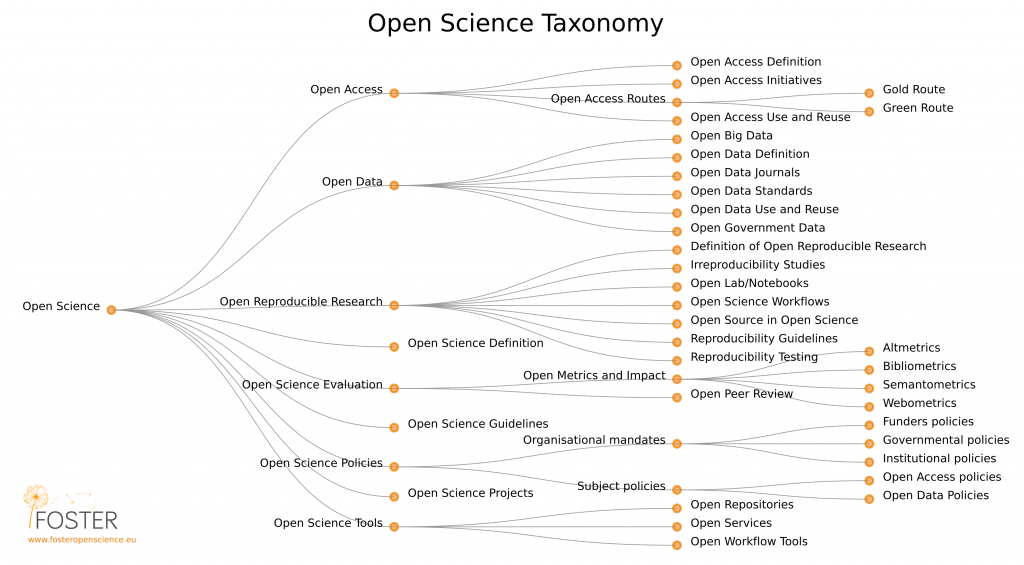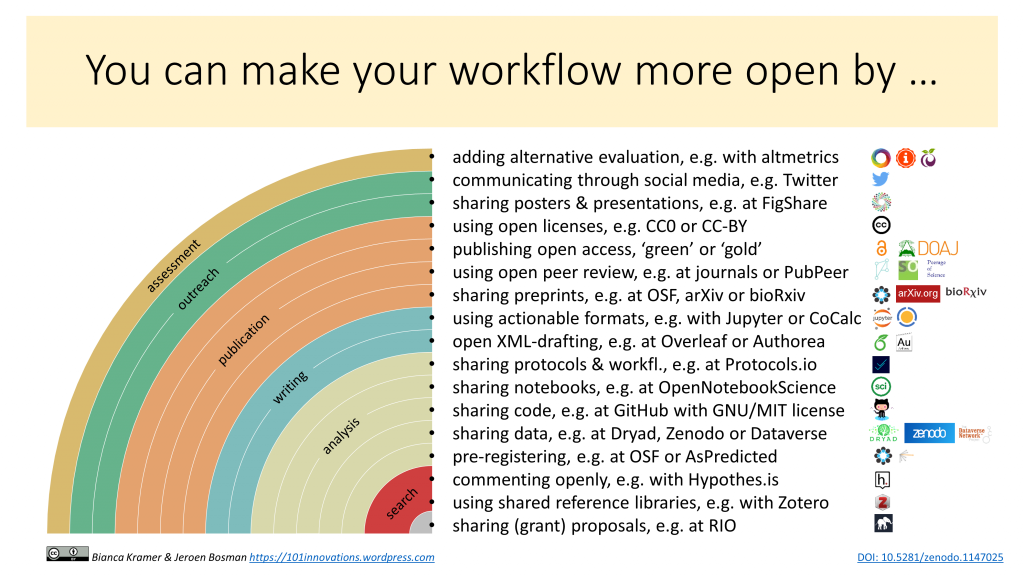Different ways to make your research more open
Open science is more than just open access to publications!
Publishing in open access journals is great but open science is more than that. Open science actions can be promoted in several sectors and levels (Fig. 6).

Consider what you, as a researcher, can do to make your research more open. Here are some ideas. As an open science practitioner, you should also…
…Share your data
The research data that underpins publications should be accessible to support validation and facilitate data reuse. In cases where data sensitivities won’t allow open access, be sure to provide, at least, the descriptive metadata. The sharing of research data will be more discussed in Open research data.
…Share your code
Many researchers now develop bits of code to help them analyse and/or visualise the data they have collected. Having access to this code, in case your research involves codes, is essential for supporting the validation of your findings and to help others to build upon your work.
…Share your workflows
Without knowing what steps were taken to capture, process and analyse the data – and in what order – it may be impossible to validate published findings or to reuse data.
…Use collaborative platforms
Research collaboration is growing exponentially and teams are becoming ever more interdisciplinary as researchers increasingly work in international and cross-disciplinary consortia to enable a multitude of perspectives on specific research questions. Fostering national and international collaborative research is also increasingly a funder priority.
Online collaborative platforms connect geographically-dispersed researchers to enable them to cooperate on their research, sharing research objects, ideas and experiences. Collaborative platforms are usually online services that provide a virtual environment to which multiple people can concurrently connect and work on the same task.
Watch an inspiring example of scientific collaboration: Crowdsourcing is Revolutionising Disease Control (5:25).
Many research organisations provide safe IT solutions for collaborative research. Discuss with the IT services of your organisation about their options. There are also several EU funded services available for researchers, such as Collaborative Data Infrastructure by EUDAT or the European Open Science Cloud EU Node environment under development.
… Involve the citizens
Citizen science is a product of successful science communication and public engagement. It is the involvement of the non-academic public in the process of scientific research.
So, do you already speak open science? Read an article by Masuzzo & Martens (2017) to learn more about open science and what you can do.

Citizen science
Citizen science can refer to citizens actively and openly participating in the research process itself, often through crowdsourcing activities. This includes aspects such as data collection and analysis, description of research data, volunteer monitoring, and distributed computing, thus making a valuable contribution to science. Citizens can participate in scientific work often by working together with experts or scientific institutions.
An example of involving the citizens in science: Foldit – Biology for gamers (6:02). FOLDIT is crowdsourcing computer game to understand protein structures. Anyone can play and contribute.
Citizen science can also mean greater public understanding of science facilitated through access to information about the research process, including the ability to use open research data and to access to journal articles. Nowadays researchers have numerous ways with which to disseminate their work to wider non-academic audiences. Whereas research has been traditionally disseminated narrowly via research articles, conference papers and book publications, researchers can now use blogs, social media, video-hosting sites, and a wide range of social digital networks to target and broaden the dissemination of their work. Which are your ways?
If you are planning a citizen science project, there are some key questions that must be taken into account:
- How are you going to engage the citizens?
- How are you going to ensure data quality?
- How are you going to deal with ethical and legal issues?
Tips for opening up your research at different stages of the research cycle – Consider these
During the planning stage
- Do you already have an ORCID identifier? If you don’t have it, register now to have your own unique ORCID iD. ORCID provides a persistent digital identifier (an ORCID iD) that you own and control, and that distinguishes you from every other researcher. You can connect your iD with your professional information — affiliations, grants, publications, peer review, and more. You can use your iD to share your information with other systems, ensuring you get recognition for all your contributions, saving you time and hassle, and reducing the risk of errors.
- Have you checked data repositories to see if there is existing data that you can reuse or build upon during your research rather than starting from scratch?
- Could you contemplate writing e.g., a blog post or posting on an academic networking service (e.g. ResearchGate, Academia.edu) outlining your ideas and approaches early on to get community feedback?
- Consider publishing your scientific work as a Registered Report where peer-review is done before results are known.
During the research
- Would you like to share your methodologies and early findings via preprints (see Choosing a suitable option)? This is a great way to get peer feedback early on and it helps you to identify any errors or problems with your approach before you publish. However, check form the potential publisher that sharing preprints early on is ok.
- Worried about getting scooped if you share early? Pre-registering your study gives you time-stamped evidence of your ideas. Examples of preregistration repositories:
- OSF (domain-general preregistration repository service with multiple formats for preregistration)
- AsPredicted (domain-general registry service providing standardised
preregistration template) - Preclinicaltrials.eu (preclinical animal study protocols)
- PROSPERO (health and social care)
- Could you consider involving citizen science in analysing the data you have generated or collected? This can dramatically increase the amount of data that you can realistically analyse in a short space of time and meaningful public engagements are generally viewed very favourably by grant application reviewers.
Towards the end of your project
- Have you published in an open access journal and/or deposited your publications in a publication repository? This means that anyone can read – and cite – your findings in the short and longer term. That all adds up to more citations for you!
- Many journals nowadays require to also open the research data first for peer-review and after publication to everyone. You can do this easily by depositing your data with an embargo to a repository. This way you can first give private link for peer-review and later open the dataset for everyone.
- Link your papers, data and code to each other through digital persistent identifiers (PIDs), such as DOIs. Link all of these back to you e.g. through your ORCID.
- Could you consider writing a popular summary about your research approach and findings to make your research accessible to non-experts? Bear in mind, non-experts can be researchers in other fields as well as journalists and the general public. Also, remember to utilise social networking forums for academics (e.g. ResearchGate, Academia.edu) to update the progress and findings of your research process. Consider, at which points of your research you will communicate with the public.
Some tips on how to communicate effectively with the public: Start early, define your message, choose the right tone and communicate with a purpose. Watch the video: Communicate from the start – The EU Guide to Science Communication (3:06).
Open science traditions, practices and attitudes can notable vary between countries, disciplines and research organisations. Therefore it is difficult to give specific information how open science should be dealt with in a certain research field or research unit. It is highly important to openly discuss about these issues with your colleagues. Here is one example how open science can be put into practise in computer science and physics (UEF).
Also, read a commentary by Besançon et al. (2021) to see one opinion of what we have learnt about open science during the COVID-19 pandemic.
What do funding bodies expect?
As a general rule of thumb, many funders expect researchers to provide access to any publications arising from the research they fund, as well as making the underlying data required to support the validation of these published findings accessible.
This does not necessarily mean that these data need to be made open. If there are good reasons to restrict access – e.g. to protect sensitive personal data – these should be clearly stated in different contexts, including the metadata description and the data management plan (see Open research data).
Always check your funder guidelines and requirements from the funder web pages.
Remember:
- Practicing open science is more than just sharing your publications.
- There are lots of opportunities to open up your work during the research lifecycle.
- Several funding bodies expect researchers to share, at least, publications and (meta)data.
- It does take a bit more work but there are many rewards.
- Everyone has a role. How can you contribute to making science and research more open (see Fig. 7 below for inspiration)?

(1/2025 KH)
Move to the next page “What is responsible research in the context of open science?“